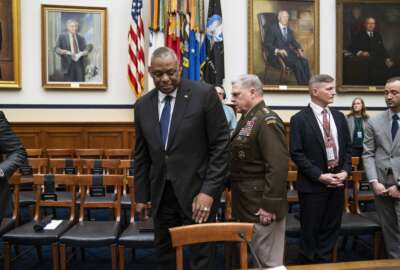
Defense officials say a year-long continuing resolution would be ‘The Bad Place’
Many of DoD’s plans and programs will have to wait if the budget goes to a year-long continuing resolution.
With no solid prospects for passage of the 2023 federal budget, the Department of Defense wants lawmakers to know just how bad life will be if they have to function for a full year on a continuing resolution (CR) instead of a real budget.
“DoD has never lived with a year-long CR. So there’s probably some levels of badness we haven’t fully explored because we haven’t had to live it yet,” said Mike McCord, DoD undersecretary of defense and comptroller at the Professional Services Council Federal Market Forecast Conference on Dec. 7.
Defense Secretary Lloyd Austin sent a press release Dec. 6, and other defense department personnel have spread the word in recent weeks about the ways a continuing resolution would affect the department’s performance as a whole.
The biggest overall problem would be the topline of the budget. McCord said the 2023 National Defense Authorization Act (NDAA) budget called for about $30 billion above last year’s budget. Additionally, Congress has indicated a willingness to give DoD $30 billion to $40 billion more than they asked for, so a full year CR would actually limit spending by $60 billion less than the money anticipated by the NDAA because the temporary measure freezes spending at the previous year’s levels.
The current CR will expire on Dec. 16. When Congress comes back next year, the House will turn over to a small Republican majority, and with it a change in leadership. Experts predict that means the budget negotiations stand a good chance of getting kicked into next year for the new Congress.
The NDAA that the House and Senate armed services committees agreed to on Dec. 6 called for a 4.6% pay raise for military members and civilian Defense Department employees. Active duty military also stand to get cost of living allowance increases. None of those are possible under a continuing resolution.
“Failure to reach an agreement would put our military and their families under additional and needless stress,” Austin said in his statement.
He said recruiting would be limited, and many changes of duty stations would have to wait.
Aside from the effects on personnel, projects ranging from construction to research and development would be put on hold.
“More than 100 military construction projects, many of which directly impact the quality of life of our people, would also be delayed. The impacts of those delays would be felt not only across the department, but also in local communities around the country as job opportunities are lost and revenue for local businesses diminishes,” Austin said.
At a time when DoD resources have been stretched by aiding Ukraine and maintaining a strong presence in the Indo-Pacific region, a new budget would mean maintaining that level of involvement as well as increased money for research and development and maintaining old systems. Pentagon Press Secretary Brig. Gen. Pat Ryder said in an email, 192 programs and projects falling under the categories of research and development and procurement would not be started under a CR. Increases in production for 49 different programs involving weapons, equipment, and munitions would not move forward.
Under the proposed NDAA, Congress would actually give DoD more money than it asked for across a broad range of categories that have support from both parties.
“We were able to touch a lot of bases all over the place, from microelectronics to sexual assault prevention, to hypersonics focused on China, protecting the triad, a number of things because we had the resources to touch a lot of bases,” McCord said. “So we’re proud of our budget, and we really want to see it get across the finish line here on the appropriation side.”
Copyright © 2025 Federal News Network. All rights reserved. This website is not intended for users located within the European Economic Area.
Alexandra Lohr, a former staff member, covered the Defense Department for Federal News Network until September 2023.
Related Stories






